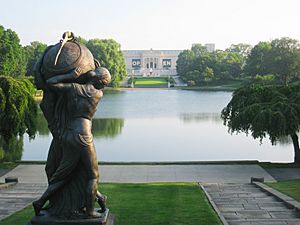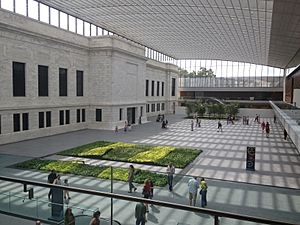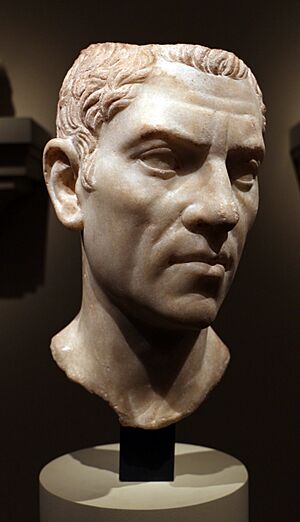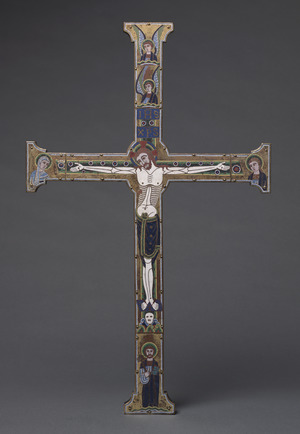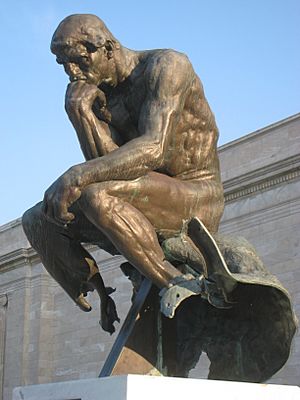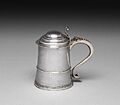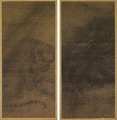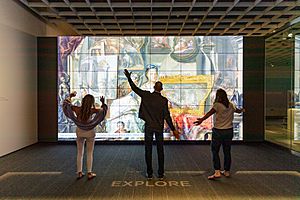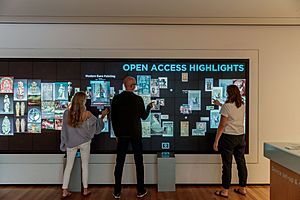Cleveland Museum of Art facts for kids
 |
|
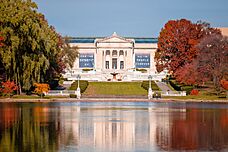 |
|
| Established | 1913 (officially opened in 1916) |
|---|---|
| Location | 11150 East Boulevard Cleveland, Ohio |
| Collection size | 66,500 works |
| Visitors | 685,336 (2023) |
The Cleveland Museum of Art (CMA) is a fantastic art museum in Cleveland, Ohio, USA. It's located in the Wade Park District of University Circle. The museum is famous worldwide for its amazing collections of Asian and Egyptian art. It has a huge collection of over 61,000 artworks from all over the globe!
The best part is that the museum offers free general admission to everyone. With a large financial fund, it's one of the wealthiest art museums in the United States. It's also one of the most visited art museums in the world, welcoming hundreds of thousands of visitors every year.
Contents
Discovering the Museum's History
The Cleveland Museum of Art was started in 1913. It received money from important Cleveland leaders like Hinman Hurlbut, John Huntington, and Horace Kelley. The beautiful building was designed in a Beaux-Arts style, using white Georgian Marble. It cost $1.25 million to build.
The museum sits on the edge of Wade Park, which was named after Jeptha Wade. He gave part of his land to the city in 1881. The museum officially opened its doors on June 6, 1916. Jeptha H. Wade II, the grandson of the park's founder, said it was "for the benefit of all people, forever." Today, Wade Park, with the museum at its heart, is a special historical place.
Growing Bigger: Museum Expansions
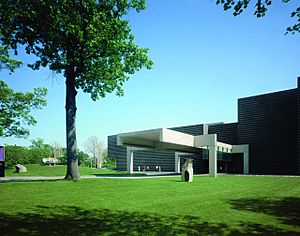
The museum has grown a lot over the years. In 1958, the first addition opened, making the museum twice as big. This new part added more gallery space and a new art library.
In 1971, another new section, called the North Wing, was added. This part looked very different from the original building, with modern, angular lines. The museum's main entrance moved to this new wing. Classrooms and lecture halls also moved, making more room for art galleries in the older part of the building.
A West Wing was finished in 1983. This addition gave the museum an even bigger library and nine new galleries for art.
Between 2001 and 2012, the 1958 and 1983 additions were taken down. A huge new building project, costing $350 million, doubled the museum's total size. This project added new east and west wings and a stunning glass-roofed atrium. The east wing opened in 2009, and the atrium and north wing in 2012. The west wing was completed on January 2, 2014.
Big Changes in the 21st Century
The museum's "Building for the Future" project was a massive renovation. It was the largest cultural project in Ohio's history. The project added two new wings and covered the central courtyard with a beautiful glass roof. This increased the museum's space by about 65%.
The museum celebrated the grand completion of this project on December 31, 2013. Many activities continued into early 2014. This big renovation made the museum even more impressive for visitors.
In June 2008, after being closed for almost three years, 19 of the museum's original galleries reopened. On June 27, 2009, the new East Wing opened, showing off Impressionist, Contemporary, and Modern art.
The ground floor of the original 1916 building reopened on June 26, 2010. It now displays art from ancient Greece, Rome, Egypt, Africa, and the Medieval period.
The expanded museum also has better facilities for visitors. These include new restrooms, a bigger store and café, a fancy restaurant, and more parking spaces. There's also a huge glass-covered courtyard, which is a great place to relax.
In June 2021, the museum opened a community arts center in a Cleveland neighborhood. It displays art and floats from past "Parade the Circle" events.
Exploring Wade Park's Art Garden
Wade Park is not just a park; it's also an outdoor art gallery! The Wade Park Fine Arts Garden displays many sculptures from the museum's collection. You can find these artworks between the museum's main entrance and the lagoon.
Some highlights include the large Fountain of the Waters by Chester A. Beach and a monument to the Polish hero Tadeusz Kościuszko. There's also a bronze sundial called Night Passing the Earth to Day by Frank Jirouch. It sits across Wade Lagoon from the museum.
Auguste Rodin's famous sculpture, The Thinker, is at the top of the museum's main staircase. In 1970, the statue was partly damaged. It was never fully repaired, which makes this particular casting unique. A plaque at its base explains the story.
Amazing Art Collections
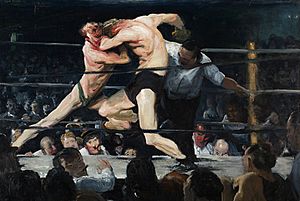
The Cleveland Museum of Art organizes its collections into 16 different departments. These include Chinese Art, Modern European Art, African Art, and Greek and Roman Art. You can also find collections of Photography, Medieval Art, and Japanese and Korean Art.
Many famous artists have their works here, such as Botticelli, Caravaggio, El Greco, Rubens, Frans Hals, Goya, J. M. W. Turner, Dalí, Matisse, Renoir, Paul Gauguin, Monet, Vincent van Gogh, Picasso, and George Bellows. The museum has also been collecting many important artworks from the later 20th century by artists like Warhol and Jackson Pollock.
The museum has a strong collection of African art, with 300 traditional works from different groups like the Bini and Yoruba peoples. Its Asian art collection is also considered one of the best in the U.S.
In 2004, the museum bought an ancient bronze sculpture called Apollo Sauroktonos. Experts believe it might be an original work by the famous Greek sculptor Praxiteles. After much study, in 2013, the museum announced that the statue was almost certainly an original work by Praxiteles himself.
In 2008, the U.S. Postal Service chose the museum's famous Botticelli painting, Virgin and Child with the Young John the Baptist, for its Christmas stamp.
Modern European Painting and Sculpture
This collection features about 537 artworks from 1800 to 1960. It includes beautiful Impressionist and Post-impressionist pieces. You can also see exciting avant-garde art styles and German Expressionism.
-
The Burning of the Houses of Lords and Commons, by J. M. W. Turner, 1834–35
-
Reading, by Berthe Morisot, 1873
-
The Red Kerchief Portrait of Madame Monet, by Claude Monet
European Painting and Sculpture
This collection covers art from 1500 to 1800. It has important works from the Italian Baroque, Spanish Baroque, and Italian Renaissance periods. You'll also find significant French, British, and Dutch paintings here.
-
The Crucifixion of Saint Andrew, Caravaggio, 1607
-
Saint Paul the Hermit, Mattia Preti, 1663
-
Tieleman Roosterman, Frans Hals, 1634
-
The House in Nazareth, by Francisco de Zurbarán, about 1640
-
Holy Family on the Steps, Nicolas Poussin, 1648
-
Portrait of Cardinal Dubois, Hyacinthe Rigaud, 1723
American Painting and Sculpture
This collection has about 300 paintings and 90 sculptures. Some popular pieces include William Sideny Mount's The Power of Music and Frederic Edwin Church's Twilight in the Wilderness. The museum also highlights art from local Cleveland artists.
-
Twilight in the Wilderness, by Frederic Edwin Church, 1860
-
The Race Track (Death on a Pale Horse), by Albert Pinkham Ryder
Photography Collection
The museum has a small but important collection of fine art photography, starting from 1893. It includes works from early French, English, and American photographers. You can also see complete sets of The North American Indian by Edward S. Curtis and Camera Work.
-
A Nakoaktok Chief's Daughter
-
Walker Evans, Allie Mae Burroughs, Wife of a Cotton Sharecropper, Hale County, Alabama, 1936
Armor Court
The Jack, Joseph and Morton Mandel Armor Court has been in its original spot since the museum opened in 1916. It shows off different European arms and armor, along with banners and tapestries. These items date from medieval to renaissance times. A key piece is the "Armor for Man and Horse with Völs-Colonna Arms" from Northern Italy (around 1575). This is a full set of decorated armor for a knight and his horse, used for jousting.
Decorative Art and Design
This collection is famous worldwide. It includes useful objects where the shape and decoration are the main focus. These are not just sculptures, but beautiful items for everyday life.
Asian Art
Ingalls Library: A Treasure Trove of Books
The Cleveland Museum of Art also has the Ingalls Library. This is one of the biggest art libraries in the United States. When the museum started in 1913, the plan was to have 10,000 books. By the 21st century, the library had over 500,000 books! It also has many digitized slides. The library was a big part of the museum's $350 million expansion project.
ARTLENS Gallery: Interactive Art Fun
The ARTLENS Gallery is a super cool part of the museum. It has interactive displays and a mobile app that let you explore the museum's digital art collection. ARTLENS has four main parts:
- The ArtLens Wall is a huge 40-foot screen. You can browse and zoom in on all the artworks in the museum, and even some that aren't currently on display.
- The ArtLens Exhibition features different artworks that you can interact with using digital games. For example, you can match your hand gestures to an artwork or copy poses from paintings.
- The ArtLens Studio lets you create your own digital art. You can make digital pottery or collages using images from the museum.
- The ArtLens mobile app gives you information about the museum and its artworks. It uses Bluetooth to know where you are in the museum. You can save your favorite artworks as you explore.
Studies show that ARTLENS makes visiting the museum more fun. Most visitors felt it made their experience better and encouraged them to look closely at art. People spent much more time looking at artworks after ARTLENS was introduced!
Museum Programs and Events
The Cleveland Museum of Art offers many special events. These include art exhibitions, talks, films, and music concerts. The performing arts department brings talented artists from all over the world to Cleveland.
The education department creates programs for all ages. They have lectures, classes, and community events like "Parade the Circle" and the "Chalk Festival." These programs help people learn about art in fun ways.
Open Access to Artworks
In January 2019, the Cleveland Museum of Art made a big announcement. It decided to share high-resolution images and information for about 30,000 artworks from its collection. These are artworks that are no longer protected by copyright. This means anyone can use them for free! The museum uses a special license called Creative Commons Zero for this. You can find these Open Access materials on a special section of the museum's website.
Museum Management
The museum welcomed 597,715 visitors between July 2013 and June 2014, which was a lot! In 2018, it had a record 769,435 visitors.
The museum gets money from different sources to operate. This includes support from the Ohio Arts Council and local residents. A large part of its budget comes from interest on its special fund. The museum also has a fund to buy new artworks for its collections.
Artworks with a Past: Addressing Looted Art
Sometimes, artworks have a complicated history. The Cleveland Museum of Art works to address cases where art might have been taken unfairly in the past.
For example, there was a discussion about a painting called The Aviator by Fernand Leger. In 2013, the museum agreed to pay the family of Arthur Feldmann for a drawing that was taken from them by the Nazis during World War II. The drawing was Allegory of Christian Faith by Johann Liss. In 2017, the museum returned an ancient Roman marble head of Drusus Minor to Italy. It had been taken from a museum near Naples during World War II.
In 2023, a special team in New York took an ancient Roman bronze statue from the museum. This was part of an investigation about ancient art that was taken illegally from an ancient Roman town in Turkey. The museum worked with Turkish authorities to study the statue. They collected samples and compared the statue's feet to stone bases at the site. This research confirmed the statue came from Turkey. In February 2025, the Cleveland Museum of Art announced it would return the statue to Turkey.
Museum Directors
- William M. Griswold (2014–Present)
- Fred Bidwell (2013–2014, interim director)
- David Franklin (2010–2013)
- Deborah Gribbon (2009–2010, interim director)
- Timothy Rub (2006–2009)
- Katharine Lee Reid (2000–2006)
- Kate Sellars (1999–2000, interim director)
- Robert P. Bergman (1993–1999)
- Evan H. Turner (1983–1993)
- Sherman E. Lee (1958–1982)
- William M. Milliken (1930–1958)
- Frederic Allen Whiting (1913–1930)
See also
 In Spanish: Museo de Arte de Cleveland para niños
In Spanish: Museo de Arte de Cleveland para niños
- List of largest art museums
- List of most-visited art museums
- List of most-visited museums in the United States


